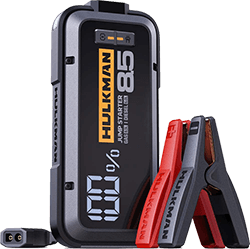Recent Articles
-
Understanding Lithium Battery Charging: Principles, Challenges, and How Hulkman Mega Engineers a Smarter System September 29, 2025
-
What Are Lithium Battery Cycle Counts and How to Extend Them? September 25, 2025
-
How to Properly Care for Lithium Battery Products September 24, 2025
Featured Products
note
What It Means for a Power Station to Work at 13,000 ft
When most people think of portable power stations, they imagine weekend camping trips, backyard movie nights, or keeping a laptop charged during a blackout. But for explorers, filmmakers, drone pilots, and climbers, the real test comes far away from cities—sometimes thousands of feet above sea level.
Being able to operate reliably at 13,000 feet (around 4,000 meters) isn’t just a marketing claim. It means surviving in some of the harshest natural conditions on Earth, where batteries, electronics, and even the human body are pushed to their limits. Let’s unpack why high altitude matters, what it does to batteries and precision devices, and where exactly in the U.S. you’ll find mountains that test such extremes.
In this article, we’ll cover:
- High Altitude Challenges for Lithium Batteries
- High Altitude Strain on Devices
- U.S. Mountains Under 13,000 ft
- Why Mega Power Station Thrives at 13,000 ft
High Altitude Challenges for Lithium Batteries
Operating a lithium battery at altitude means dealing with four harsh factors: low pressure, low temperatures, reduced oxygen levels, and stronger UV radiation. Each of these conditions accelerates battery degradation if not engineered against.
- Low Pressure: For every 1,000 m gained, air pressure drops ~12%. This thins air density, which reduces cooling efficiency by ~30%. Fans push less air mass, raising pack temperature 4–6 °C. Low pressure also increases electrolyte vapor pressure, raising swelling risks in pouch cells.
- Low Temperature: Air cools ~6.5 °C per 1,000 m ascent. At −20 °C, electrolyte conductivity falls to just one-fifth of its room-temperature value. Lithium ions move sluggishly, polarization rises, and lithium plating plus dendrite growth shorten battery life.
- Reduced Oxygen: Lower oxygen partial pressure destabilizes cathode chemistry. According to DOE studies, this accelerates SEI thickening and reduces capacity retention in long-term cycling.
- Stronger UV Radiation: UV exposure grows 10–12% per 1,000 m elevation. At 4,000 m, a battery pack ages as if exposed to nearly 1.5× the photon dose of sea level. PET packaging materials turn brittle, yellow, and crack at up to 3× the rate of flatland storage.
High Altitude Strain on Devices
It’s not just batteries—precision electronics also falter.
-
Cameras
Photographers know that alpine and winter settings are breathtaking—but also brutal on gear. The cold doesn’t just stunt performance—it can suddenly kill a camera’s battery, and it often happens just when the light is perfect.
From National Geographic, photographer Chris Gibbs (Minnesota) said: “Without battery power, nothing works. I usually keep a set of batteries inside my coat close to my body. In extreme cold, I have had to change batteries with every click of the shutter.” He shoots in deep snow and ice, and notes that batteries drop in charge much faster than in milder conditions.
On Reddit, a user testing a Leica Q2 in light snow (~7-8 °C / ~45-50 °F) reports: “The battery drained very quickly—within about two hours, the camera was shutting down automatically. As soon as we came down from the mountain, it started working again as if nothing had happened.”
Another Reddit post describes a shoot at around −20 °C with a Nikon D90 and Leica M10: “They stopped working abruptly. They worked fine when I went back to ~20-degree weather though.”
From “Coping with the Cold” by Nick Dale Photography: “After only a few hours, the zoom froze up completely, and I was forced to take all my shots at 125mm! That was a big blow, and when my battery died … I missed out on dozens of close-ups… Batteries lose their charge very quickly in cold weather, so it’s worthwhile packing as many as you can.”
-
Drones
Drone pilots frequently share altitude challenges: “Has anyone noticed that the batteries drain faster at high altitude? It make sense because of the thinner air, the motors must work harder. I was flying yesterday at about 6,300 ft elevation … it flew fine but not as long.” (Yuneec Drone Forum)
“It’s called density altitude. The higher the elevation, the thinner the air … The thinner the air the harder the drone has to work to achieve altitude or maintain control.” (dronepilots.community)
These real-life comments mirror lab findings: thin air increases motor load and battery stress.
-
Expeditions
Mountaineers and researchers report shortened mission times when batteries drain prematurely, sometimes losing critical GPS or sensor data.
U.S. Mountains Under 13,000 ft

Here are some iconic peaks where power stations must perform:
Mount Hood (Oregon, ~11,240 ft / 3,426 m)
Feature & History: Iconic Cascade stratovolcano; glaciers, alpine skiing, historic Timberline Lodge; frequent winter storms and heavy snow.
Traveler Experience: “My iPhone 8 … The battery drains faster it used to. It’s ok in summer, but this time of year … if I’m out in anything below 45 degrees my phone battery can go from 100% to 50% in about two hours even in airplane mode.” (Oregon Hikers)
Half Dome (California, ~8,839 ft / 2,694 m)
Feature & History: Yosemite’s granite icon, famous cables route, massive vistas; Native American history and early mountaineering lore.
Traveler Experience: “My phone was at 30 percent at the top of Half Dome. I had AllTrails recording our hike the entire time. … I used my magnetic power bank otherwise my phone would have died also.” (Reddit)
Humphreys Peak (Arizona, ~12,633 ft / 3,851 m)
Feature & History: Highest in Arizona; alpine tundra, volcanic geology, ecological transitions from desert to snow.
Traveler Experience: From guest post by hiker “Timothy”, Timothy notes that nights at the high elevation base camps were bitterly cold, and that he carried extra power banks and wrapped devices close to his body to stop“electronics from dying during summit sunrise shoots.”(She Dreams of Alpine)
Why Mega Power Station Thrives at 13,000 ft
Most portable batteries aren’t designed for such extremes. The Mega power station is:
- Engineered with dual-fan thermal management to offset thin-air cooling losses.
- Built with reinforced cabling and casing materials to resist cold and UV damage.
- Tested for stable operation at altitudes beyond 13,000 ft, ensuring 1.5–2× the reliability of conventional stations.
- Backed by a 5-year warranty, Mega isn’t just a power station—it’s a trusted partner for alpine climbers, drone pilots, photographers, and researchers.
Learn more and get a hidden exclusive discount by clicking here.






















